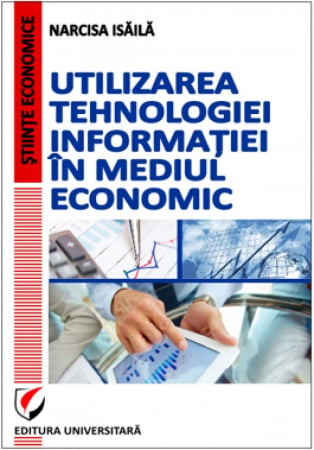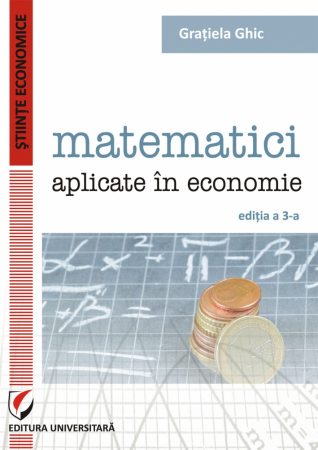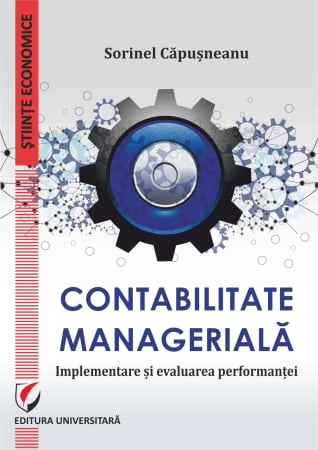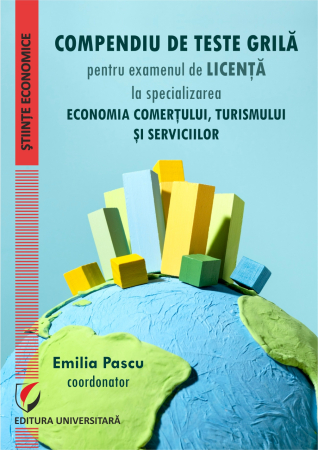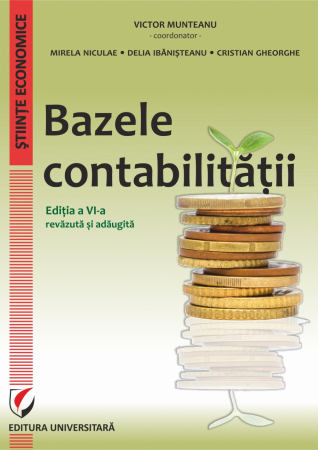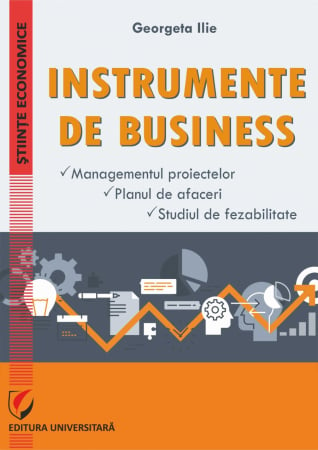Manuscript proposals: [email protected] / 0745 204 115 //// Tracking orders Individuals / Sales: 0745 200 357 / Orders Legal entities: 0721 722 783
Publisher: Editura Universitară
Author: Floarea Georgescu
ISBN: 978-606-28-0465-7
DOI: 10.5682/9786062804657
Publisher year: 2016
Pages: 154
Product Code:
9786062804657
Do you need help?
0745 200 357
- Description
- Download (1)
- Authors
- Content
- More details
- Reviews (0)
This paper addresses how to achieve the short-term balance of the enterprise from three points of view, related to the structure of the treasury, economic-financial analysis and financial management.
We started this approach from the idea that the company, being placed in a complex system of economic and financial relations, must face all financial obligations. Starting from the business objective, to create added value for shareholders, following the economic decisions taken by the company's management, we can define value creation as a favorable balance between the cash resulting from the business and the one invested in the business.
Through the approached problem, we aimed to demonstrate the fact that, in the short term, the treasury plays an important role in the development and efficiency of the activity of any enterprise.
Any financing decision from sources other than your own must be taken taking into account the existing market conditions, the ability to return the funds, but also the forecasts for longer periods of time (in the case of medium and long-term loans) and the cost of procured sources.
We started this approach from the idea that the company, being placed in a complex system of economic and financial relations, must face all financial obligations. Starting from the business objective, to create added value for shareholders, following the economic decisions taken by the company's management, we can define value creation as a favorable balance between the cash resulting from the business and the one invested in the business.
Through the approached problem, we aimed to demonstrate the fact that, in the short term, the treasury plays an important role in the development and efficiency of the activity of any enterprise.
Any financing decision from sources other than your own must be taken taking into account the existing market conditions, the ability to return the funds, but also the forecasts for longer periods of time (in the case of medium and long-term loans) and the cost of procured sources.
-
Managementul trezoreriei intreprinderii. Probleme, abordari, metode
Download
FLOAREA GEORGESCU
Introduction / 11
Chapter 1: Critical analysis of the state of knowledge in the field of enterprise treasury / 16
1.1. Enterprise treasury - etymology and semantics / 16
1.2. The current state of knowledge in the field of enterprise treasury / 19
1.3. Treasury components classified and recognized in accounting / 25
1.3.1. Short - term financial investments / 26
1.3.2. Values receivable / 29
1.3.3. Cash at the bank and at home / 31
1.3.4. Short - term bank loans / 33
1.3.5. Letter of credit and other treasury values / 34
Chapter 2: Analysis and interpretation of cash flows / 36
2.1. The objectives of the financial analysis. Classifications and approaches / 36
2.2. Free flow analysis, discretionary. Models and interests / 40
2.3. Forecast analysis of cash flows / 46
Chapter 3: Approaches and methods in the financial management of the enterprise treasury / 49
3.1. Domain of definition and action / 49
3.2. Management of receipts and payments / 54
3.2.1. Revenue management / 54
3.2.2. Payment management / 57
3.2.3. Cash balance management / 58
3.3. Cash balance management models / 63
3.3.1. Models for determining the optimal cash balance / 63
3.4. Statistical analysis in SPSS of the short - term activity of the enterprise / 69
Conclusions, noted problems, proposals / 109
Bibliography / 115
Annexes / 123
Chapter 1: Critical analysis of the state of knowledge in the field of enterprise treasury / 16
1.1. Enterprise treasury - etymology and semantics / 16
1.2. The current state of knowledge in the field of enterprise treasury / 19
1.3. Treasury components classified and recognized in accounting / 25
1.3.1. Short - term financial investments / 26
1.3.2. Values receivable / 29
1.3.3. Cash at the bank and at home / 31
1.3.4. Short - term bank loans / 33
1.3.5. Letter of credit and other treasury values / 34
Chapter 2: Analysis and interpretation of cash flows / 36
2.1. The objectives of the financial analysis. Classifications and approaches / 36
2.2. Free flow analysis, discretionary. Models and interests / 40
2.3. Forecast analysis of cash flows / 46
Chapter 3: Approaches and methods in the financial management of the enterprise treasury / 49
3.1. Domain of definition and action / 49
3.2. Management of receipts and payments / 54
3.2.1. Revenue management / 54
3.2.2. Payment management / 57
3.2.3. Cash balance management / 58
3.3. Cash balance management models / 63
3.3.1. Models for determining the optimal cash balance / 63
3.4. Statistical analysis in SPSS of the short - term activity of the enterprise / 69
Conclusions, noted problems, proposals / 109
Bibliography / 115
Annexes / 123
Through the content of this paper, entitled Enterprise Treasury Management - problems, approaches and methods, we try to provide a relevant analysis of the main aspects of enterprise treasury, as a foundation in conducting economic transactions, while presenting both the theoretical side of the phenomenon and on the practical one.
We considered it necessary to present and develop this topic, as complex as it is current, from three perspectives, as follows: from the perspective of the stage of knowledge, of the economic-financial analysis and last but not least from the perspective of treasury management.
Starting from these considerations, the objective of this paper is to make a theoretical and practical analysis of the main aspects related to the concept of cash flow, starting from the structures and components of the treasury classified and recognized in accounting, continuing with financial analysis and interpretation of flows. of treasury, in order to finally approach the treasury of the enterprise from the point of view of financial management.
Starting from the proposed research directions, we tried to develop in a personal way the complexity of the aspects related to the company's treasury, which appear in the content this paper, as follows:
In the first chapter, entitled Critical Analysis of the state of knowledge in the field of enterprise treasury, we first presented the semantics and etymology of the word treasury, where we researched the meanings of the word and its evolution over time, but also the interpretation given by the university elite. in the field of enterprise treasury, in order to finally address the structures and components of the treasury classified and recognized in accounting.
In the second chapter, called Analysis and interpretation of cash flows, starting from the objective of financial analysis we conclude that an adequate economic analysis focuses on cash flows, ie on the net cash generated by the confrontation between receipts and payments.
Regarding the cash flows generated by the company to owners and creditors, we noted and stressed that not the entire management cash flow is used for their remuneration but only the remaining part after financing investments in fixed assets and the variation of net current assets.
Our conclusions and proposals, regarding the cash flow available for the remuneration of shareholders and creditors, we consider to be extremely useful in diagnosing profitability, because it contributes to the correct information about the company's ability to produce profit in close connection with its ability to generate cash. flow.
Next, starting from the financial analysis, we found that the dividend policy can be an extremely interesting field of study and we tried to find answers to questions such as: "What is the purpose of dividend distribution?", "What is the optimal dividend policy ? ”, What is the impact of dividends on the value of the company. Thus, we found that against the background of the current economic crisis, the needs of liquidity and financing sources have become priorities for companies, and we will probably witness radical changes regarding the dividend policy.
Also in this chapter we focused our study on the future perspective, respectively on the forecast of future economic conditions, a task considered of utmost importance for the management of any business. In this context, we analyzed the key concepts and techniques for predicting operational performance and financial needs, which would support the future operations of a company.
Forecasting financial needs is an essential component of the business planning process. On this basis, the management bases its position on future activities, depending on the forecasted economic, competitive and technological environment. The elaboration of the business plans supposes the structuring of the entire activity around specific objectives. These plans establish the strategies and actions necessary to achieve the desired results in the short, medium or long term, with special attention being paid to the need to create value for shareholders, by obtaining a return higher than the cost of capital invested and promoting coherent growth investments. long.
In the last chapter of the paper, entitled Approaches and methods in the financial management of the company's treasury, we will focus on how they are oriented, based on the principle of business continuity, cash inflows and the need to finance current operations. Managers should understand and know the specific movements of cash within the business system, determined by daily decisions on operating, investing or financing activities, as well as a wide range.
of external circumstances that affect the company's activity. Such decisions and events may affect the company's ability to pay its obligations, obtain loans from suppliers, banks or credit institutions, and maintain an operational level consistent with the company's products and services through investments.
I noticed that in any company, the management of receipts and payments is an extremely important activity, we can even say vital for its existence. The main objective of this activity aims at sizing and correlating the operations that generate receipts and payments so as to obtain a balance and to avoid situations of inability to pay or the formation of a surplus of liquidity without immediate use.
In the last part of this chapter we made a case study using a database for 2014, which includes information from the Financial Statements of the analyzed companies, but also from other informative data, for a number of 98 companies. The companies have as object of activity the cultivation of cereals (excluding rice), leguminous plants and oilseed plants - CAEN CODE 0011. Between the variables Debts, Stocks, House and bank accounts and Receivables, with a sufficiently large number of observations in data series, we tested the existence of a link. For a significance threshold of 5%, dependencies were identified between the following variables: Inventories and Debts, Inventories and House and bank accounts, Receivables and House and bank accounts, Receivables and Debts and Debts and House and bank accounts. Descriptive statistics were calculated in SPSS 20 for all variables in the database.
The data are taken from the websites of the National Bank of Romania and the Ministry of Public Finance, and the data processing is done with the computer program SPSS 20.
The research methods used are diverse depending on the aspects, theoretical or practical, analyzed. In this context, various studies promoted by the literature were used, databases presenting scientific articles, specialized analyzes published in national and international economic journals, related to the main flow of publications. Thus, for the collection, registration and processing of theoretical data began with the study of bibliography and documentation, which allowed a complex approach to the specific issues of treasury activities in order to collect data necessary to study the phenomenon. Also, aspects related to the capitalization of accounting information in the decision-making process were addressed, which aimed at the issue of information sources in the forecast analysis of cash flows and the analysis of the decision-making process based on the accounting information system.
In terms of content, we would like this paper to be a starting point especially for future economic and financial analyzes, but also a set of guidelines that can be used by companies in the process of value formation.
We considered it necessary to present and develop this topic, as complex as it is current, from three perspectives, as follows: from the perspective of the stage of knowledge, of the economic-financial analysis and last but not least from the perspective of treasury management.
Starting from these considerations, the objective of this paper is to make a theoretical and practical analysis of the main aspects related to the concept of cash flow, starting from the structures and components of the treasury classified and recognized in accounting, continuing with financial analysis and interpretation of flows. of treasury, in order to finally approach the treasury of the enterprise from the point of view of financial management.
Starting from the proposed research directions, we tried to develop in a personal way the complexity of the aspects related to the company's treasury, which appear in the content this paper, as follows:
In the first chapter, entitled Critical Analysis of the state of knowledge in the field of enterprise treasury, we first presented the semantics and etymology of the word treasury, where we researched the meanings of the word and its evolution over time, but also the interpretation given by the university elite. in the field of enterprise treasury, in order to finally address the structures and components of the treasury classified and recognized in accounting.
In the second chapter, called Analysis and interpretation of cash flows, starting from the objective of financial analysis we conclude that an adequate economic analysis focuses on cash flows, ie on the net cash generated by the confrontation between receipts and payments.
Regarding the cash flows generated by the company to owners and creditors, we noted and stressed that not the entire management cash flow is used for their remuneration but only the remaining part after financing investments in fixed assets and the variation of net current assets.
Our conclusions and proposals, regarding the cash flow available for the remuneration of shareholders and creditors, we consider to be extremely useful in diagnosing profitability, because it contributes to the correct information about the company's ability to produce profit in close connection with its ability to generate cash. flow.
Next, starting from the financial analysis, we found that the dividend policy can be an extremely interesting field of study and we tried to find answers to questions such as: "What is the purpose of dividend distribution?", "What is the optimal dividend policy ? ”, What is the impact of dividends on the value of the company. Thus, we found that against the background of the current economic crisis, the needs of liquidity and financing sources have become priorities for companies, and we will probably witness radical changes regarding the dividend policy.
Also in this chapter we focused our study on the future perspective, respectively on the forecast of future economic conditions, a task considered of utmost importance for the management of any business. In this context, we analyzed the key concepts and techniques for predicting operational performance and financial needs, which would support the future operations of a company.
Forecasting financial needs is an essential component of the business planning process. On this basis, the management bases its position on future activities, depending on the forecasted economic, competitive and technological environment. The elaboration of the business plans supposes the structuring of the entire activity around specific objectives. These plans establish the strategies and actions necessary to achieve the desired results in the short, medium or long term, with special attention being paid to the need to create value for shareholders, by obtaining a return higher than the cost of capital invested and promoting coherent growth investments. long.
In the last chapter of the paper, entitled Approaches and methods in the financial management of the company's treasury, we will focus on how they are oriented, based on the principle of business continuity, cash inflows and the need to finance current operations. Managers should understand and know the specific movements of cash within the business system, determined by daily decisions on operating, investing or financing activities, as well as a wide range.
of external circumstances that affect the company's activity. Such decisions and events may affect the company's ability to pay its obligations, obtain loans from suppliers, banks or credit institutions, and maintain an operational level consistent with the company's products and services through investments.
I noticed that in any company, the management of receipts and payments is an extremely important activity, we can even say vital for its existence. The main objective of this activity aims at sizing and correlating the operations that generate receipts and payments so as to obtain a balance and to avoid situations of inability to pay or the formation of a surplus of liquidity without immediate use.
In the last part of this chapter we made a case study using a database for 2014, which includes information from the Financial Statements of the analyzed companies, but also from other informative data, for a number of 98 companies. The companies have as object of activity the cultivation of cereals (excluding rice), leguminous plants and oilseed plants - CAEN CODE 0011. Between the variables Debts, Stocks, House and bank accounts and Receivables, with a sufficiently large number of observations in data series, we tested the existence of a link. For a significance threshold of 5%, dependencies were identified between the following variables: Inventories and Debts, Inventories and House and bank accounts, Receivables and House and bank accounts, Receivables and Debts and Debts and House and bank accounts. Descriptive statistics were calculated in SPSS 20 for all variables in the database.
The data are taken from the websites of the National Bank of Romania and the Ministry of Public Finance, and the data processing is done with the computer program SPSS 20.
The research methods used are diverse depending on the aspects, theoretical or practical, analyzed. In this context, various studies promoted by the literature were used, databases presenting scientific articles, specialized analyzes published in national and international economic journals, related to the main flow of publications. Thus, for the collection, registration and processing of theoretical data began with the study of bibliography and documentation, which allowed a complex approach to the specific issues of treasury activities in order to collect data necessary to study the phenomenon. Also, aspects related to the capitalization of accounting information in the decision-making process were addressed, which aimed at the issue of information sources in the forecast analysis of cash flows and the analysis of the decision-making process based on the accounting information system.
In terms of content, we would like this paper to be a starting point especially for future economic and financial analyzes, but also a set of guidelines that can be used by companies in the process of value formation.
If you want to express your opinion about this product you can add a review.
write a review

6359.png)
![Treasury Management. Problems, Approaches, Methods - Floarea Georgescu [1] Treasury Management. Problems, Approaches, Methods - Floarea Georgescu [1]](https://gomagcdn.ro/domains/editurauniversitara.ro/files/product/large/managementul-trezoreriei-intreprinderii-probleme-abordari-metode-550-670797.jpg)

